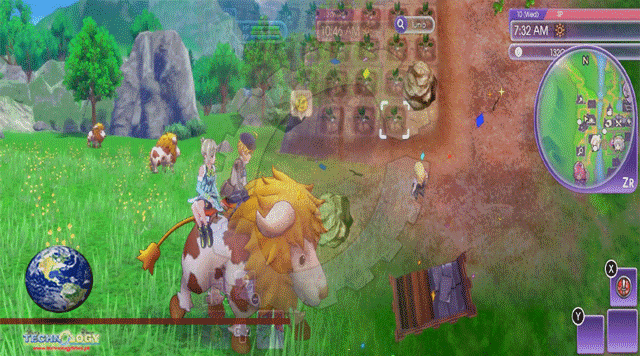Developed by Hakama Inc. and published by Marvelous (Xseed), Runic Factory 5 is the latest installment in the 15-year-old RPG franchise and is now available on Nintendo Switch.

on the surface, Runic Factory 5 has everything: giant dragons that you can ride on, dungeon crawling, farming, a butterfly boy who loves you when you give him chocolate bars. The game aims to become the next great farming simulator – and, as it should be, it is a fully 3D, third-person RPG with a huge range of activities. But by trying so much, the systems are spread thin and end up feeling half-baked, resulting in a game that doesn’t feel that great to play.
Developed by Hakama Inc. and published by Marvelous (Xseed), Runic Factory 5 is the latest installment in the 15-year-old RPG franchise and is now available on Nintendo Switch. You play as an Earthmate, part of a group of people who have a special bond with the Earth, and with the giant dragons that inhabit the world of Rune Factory. The story begins when the main character saves a young girl named Hina from monsters and then passes out after the rescue. You wake up in the town of Rigbarth to discover that you have been captured by SEED, an organization that protects the town from monsters, but you have lost your memory.
Players must build a life in the quaint town of Rigbarth and help SEED protect the town. This entails many tasks. You can befriend and fall in love with city folk, crawl into dungeons in different environments, fight monsters, capture and tame them, cook, craft, fish and farm. Days have a similar rhythm to Stardew Valley, where you play a certain day and use your stamina to fight and farm. You’ll often have to fight and complete a dungeon to move the story forward, but food and potions are plentiful from the start – making it easy to balance the battles while preserving the crops.
The game’s visual aesthetic and camera perspective are different from previous titles. Unlike its predecessor, 2012’s Runic Factory 4, this game has a floating camera that you can control yourself or use to lock targets. The art style charmingly resembles a kind of cartoonishness similar to that of Dragon Quest 11, except it also layers on filters that give the world a dewy look. Unfortunately, the game also has some immediately noticeable visual issues. Every time I left a house to go to town, the game’s frame rate dropped significantly.
Runic Factory 5The fastidious execution often made farming and other activities feel like a chore rather than a more enjoyable pastime. I experienced consistent problems with everyday life in Rigbarth. This included stacking objects: objects don’t move each other, they are just placed on top of each other, so I would often misplace one object and see it merge into another large object. Setting up storage bins in my field also felt surprisingly sensitive. Bins wouldn’t automatically align, so my crops are now lined with boxes that are slightly off-parallel to the field. As in previous Rune Factory games, you can throw items into the sales and storage bin from a distance. It’s fun in theory, but the game makes you use an automatic locking system that frustratingly tends to lock onto the myriad other objects around your farm. Many times I would run over individual items in my head because it was just easier than doing it the “right” and most optimal way.
Dungeon crawling was similarly held back by counterintuitive systems. Early in the game, dungeon crawling becomes an important way to unlock characters, as well as completing tasks such as catching monsters and earning new bubble land. But the game went awry trying to get a full-fledged combat system where players can lock enemies and combine them. Leaving the hack-and-slash of previous titles left me with a combat system and dash that felt like I was hovering over the battlefield, with no real thrust behind my actions. The lock-on system often misdirected my slashes as it jumped between targets on a field full of monsters.
Despite these mechanical issues, the game’s characters still made this world a bit of fun to spend time in. Each character had an outspoken, charming personality, such as the lively and spry Murakumo or the gruff Ryker. When talking to each character, their character art and expressions made the conversation feel like playing an interactive novel or dating sim. I spent most of my playing time talking to people and considering each character for possible romance.
I felt really conflicted about who I should date – I started out with an interest in Martin, the lone blacksmith, but was eventually won over by Murakumo’s jovial spirit. The game creates cute romantic moments, and at one point, while he was talking to Martin, his character art “bumped” into mine on the screen to show him he bumped into me while lost in thought. Such a small bloom took me deeper into those conversations and characters. You can also romanticize same-sex characters, which is a welcome addition.
There are some additional positive quality of life changes in this game. Your items don’t take days to upgrade; there are teleportation points on maps that are accessed at a relatively early stage; and you can unlock bag upgrades quite quickly and easily. However, the general nervousness and ongoing frustration prevented me from enjoying this bloom to the fullest.
Runic Factory 5 eventually felt overwhelmed by the effort to modernize. The design of the older titles, limited by old hardware, helped narrow the focus for gameplay. Going from a top-down to a 3D interface, with execution issues, made the game feel clunky and difficult to play. Ultimately, it can’t compare to modern farming sims like Stardew Valleyy, or even the previous Rune Factory games. And as I played, I found myself looking back rather than enjoying this new attempt at modernity.
Source: vabsaga